The Cologne Cathedral is the largest cathedral of Germany and once the tallest building in the world. The cathedral is the seat of the Archbishop of Cologne. The Cologne Cathedral was built from 1248 to 1880, with interruptions, it took 632 years! The Cologne Cathedral was built mostly according to its medieval plans and drawings, but utilising more modern construction methods. Cologne Cathedral was modelled after Chartres Cathedral in France. The completion of the cathedral was celebrated as a national event in 1880 and was attended by Emperor Wilhelm I. The cathedral is a renowned monument of Gothic architecture. The 24-ton St. Peter's Bell, the Sankt Petrus Glocke, is the largest free-swinging bell in the world. The Sankt Petrus Glocke, also known as Dicker Pitter, was cast in 1923. The bell hangs in the belfry of the south tower of the cathedral. The Cologne Cathedral houses the relics of the Three Kings. The shrine of the Three Kings was created around 1200, it is the largest and most important reliquary in the Western World. The relics of the Three Kings have made the Cologne Cathedral famous. Together with Aachen Cathedral and Trier Cathedral, the Cologne Cathedral is a major Christian pilgrimage site in Germany. The cathedrals are situated on the Route of Santiago de Compostela. The Cologne Cathedral survived WWII, the cathedral was hit by 14 aerial bombs but did not collapse. The twin spires of the cathedral are said to have been used as a navigational landmark by Allied aircraft during WWII. Most of the restoration works on the Cologne Cathedral were completed in 1956. The Cologne Cathedral gained the status as a UNESCO World Heritage in 1996.
www.werelderfgoedfotos.nl © Copyright World Heritage Photos
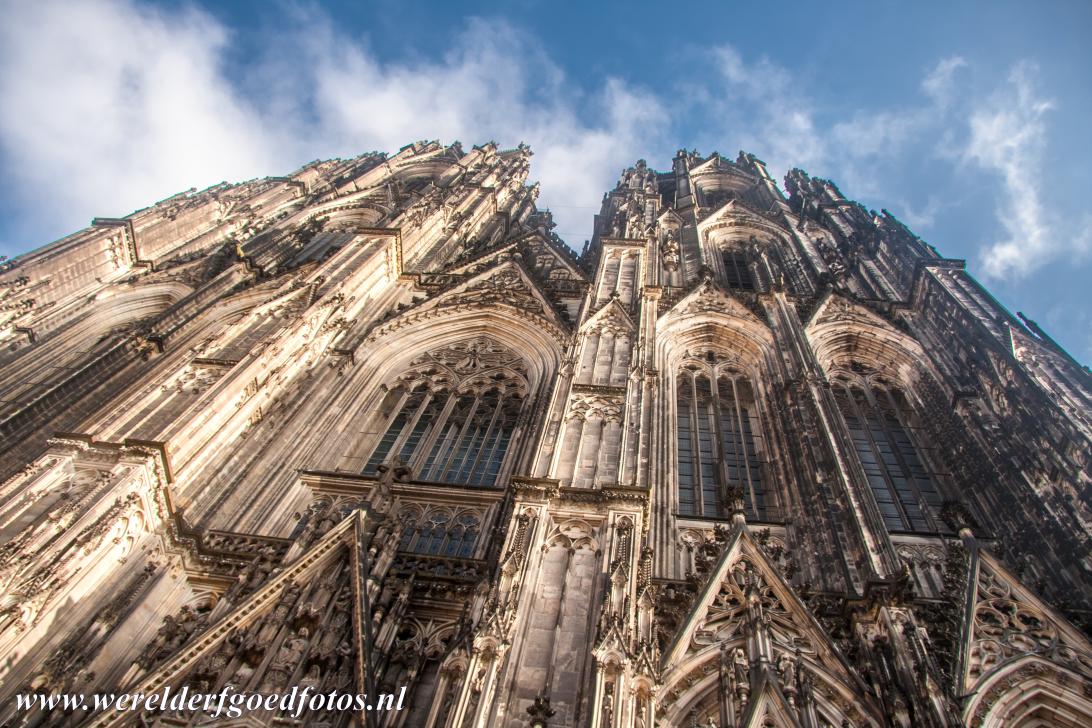
Cologne Cathedral was built between 1248 and 1880, with interruptions, it took 632 years! It is the largest cathedral in Germany and once the tallest building in the world. Cologne Cathedral was built to house the relics of the Three Kings, also known as the Three Magi. The cathedral is the most visited tourist destination in Germany. Cologne Cathedral is a UNESCO World Heritage.

Cologne Cathedral was built between 1248 and 1880, with interruptions, it took 632 years! It is the largest cathedral in Germany and once the tallest building in the world. Cologne Cathedral was built to house the relics of the Three Kings, also known as the Three Magi. The cathedral is the most visited tourist destination in Germany. Cologne Cathedral is a UNESCO World Heritage.
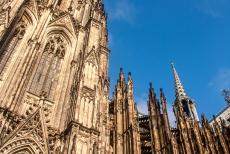
Cologne Cathedral: The towers are 157 metres high. Cologne Cathedral was completed in 1880, 632 years after construction began. Cologne Cathedral was built mostly according to medieval plans and drawings, but utilising modern methods of construction. The completion of Cologne Cathedral was celebrated as a national event, it was attended by Emperor Wilhelm I, the Kaiser.
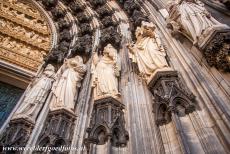
Cologne Cathedral: The statues of the Main Portal (central portal) of the west façade. The other portals of the west façade are St. Peter's Portal and the Portal of the Three Kings, also known as the Magi Portal, the west façade is the largest church façade in the world. The immense Cologne Cathedral has a total of twelve doors. The cathedral is the seat of the Archbishop of Cologne.
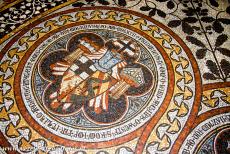
The mosaic floor of Cologne Cathedral. The 1350 square metres mosaic floor is considered the largest piece of art in Cologne Cathedral. The total area of the cathedral measures 8000 square metres and has room more than 20,000 people. Cologne Cathedral is one of the largest Gothic churches north of the Alps. Cologne Cathedral was declared a UNESCO World Heritage in 1996.
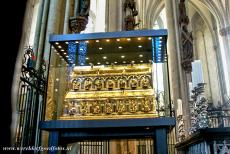
Cologne Cathedral: The Shrine of the Three Kings holds three golden crowned skulls believed to belong to the Three Kings. The shrine, a masterpiece of medieval goldwork, was created around 1200, the shrine is the most important religious reliquary in the Western World. The relics of the Three Kings have made the cathedral a major Christian pilgrimage destination for centuries.
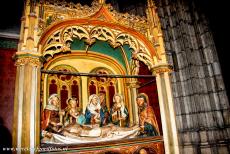
Cologne Cathedral: The 14th Station of the Cross, Jesus is laid in the tomb. Cologne Cathedral is located along the Pilgrimage Route of Santiago de Compostela. The shrine of the Three Kings or the Three Magi has attracted pilgrims for centuries. The relics of the Three Kings were donated to the cathedral in 1164 by the Holy Roman Emperor Frederick Barbarossa.
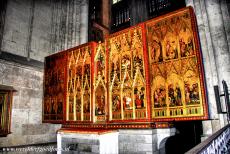
Cologne Cathedral: The 14th century Clara Altar in one of the chapels of the cathedral. The altar is made up of a large number of wooden panels, the panels are separated by wood carvings in the Gothic style. The Clara Altar was originally painted for a 14th century Franciscan nunnery in Cologne, the panels depict scenes from the life of Christ the Saviour.
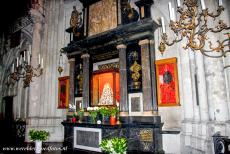
Cologne Cathedral: The Jeweled Madonna, the Schmuckmadonna, with votive gifts. The Jeweled Madonna is a small statue, it depicts the Virgin Mary. The votive gifts are pinned to the white silk robe of the Madonna. The miracle-working Jeweled Madonna dates from the 17th century. Until today, the Baroque statue attracts the attention of pilgrims.
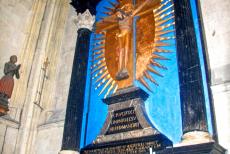
Cologne Cathedral: The 10th century crucifix of Bishop Gero is known as the Gero Cross. The Gero Cross (German: Gero-Kreuz) is the oldest surviving monumental crucifix north of the Alps. The cross is a treasure of Ottonian Romanesque art and was carved in a style ahead of its time. The Gero Cross is one of the major pilgrim stops in Cologne Cathedral.
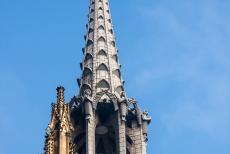
A pinnacle of Cologne Cathedral. Cologne Cathedral survived WWII, it was hit by fourteen aerial bombs but did not collapse. The twin spires of Cologne Cathedral are said to have been used as a navigational landmark by Allied aircraft raiding deeper into Germany during WWII. Most of the restoration works on the Gothic Cologne Cathedral were completed in 1956.
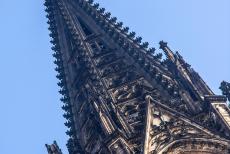
One of the spires of Cologne Cathedral. Cologne Cathedral has eleven church bells. The Sankt Petrus Glocke (St. Peter's Bell), also known as Dicker Pitter, was cast in 1923. The 24-ton Sankt Petrus Glocke is the largest free-swinging bell in the world. Its clapper weighs about 600 kg and is 3.20 metres long. Cologne Cathedral was added to the UNESCO World Heritage List in 1996.
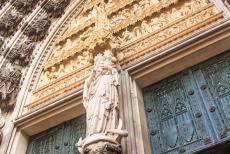
Cologne Cathedral: The main portal and the statue of the Blessed Virgin Mary. The cathedral houses numerous treasures. The relics of the Three Kings were donated to Cologne Cathedral in 1164. The oldest stained glass window was crafted in the 13th century. A modern stained glass window was made by Gerhard Richter in 2007 to replace a window that was destroyed in WWII.
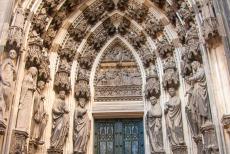
Cologne Cathedral: The Porch of the Three Kings, also known as the Magi Portal. The tympanum depicts the Appearance of the son of God to the peoples of the world. In 1945, American troops used Cologne Cathedral as a rifle range, the original heads of the statues on the doorposts were damaged during WWII and replaced in 1958-1960.
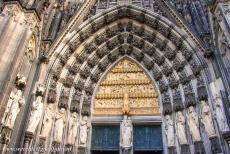
Cologne Cathedral: The Main Portal is adorned with the statue of the Blessed Virgin Mary, the large statues on the doorposts depict biblical figures, such as John the Baptist, Moses and Noah. Cologne Cathedral was modelled after Chartres Cathedral in France. Religious art and religious clothing, and medieval goldsmiths works are housed in the Cathedral Treasury.
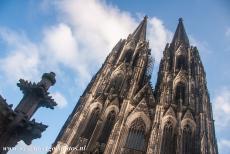
Cologne Cathedral had no towers for more than 350 years, it was not until 1880 that the towers were constructed. They were built in the Gothic style, according to the original plans from 1248. In 1880, the completion of Cologne Cathedral was celebrated, the celebration was attended by the German Emperor Wilhelm I, the first emperor of Germany.
